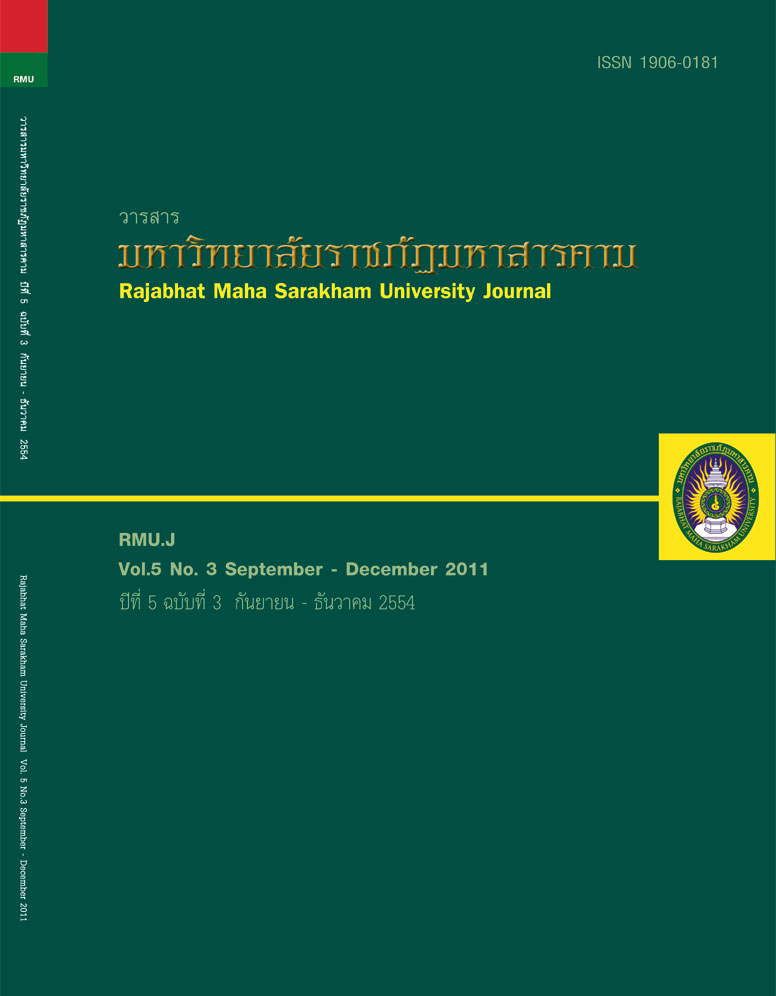การพัฒนาการคิดอย่างมีวิจารณญาณของผู้นำชุมชนเมือง : กรณีศึกษา เทศบาลเมืองมหาสารคาม; A Development of Urban Community Leaders’ Critical Thinking: In Case of Muang Maha Sarakham Municipality
Main Article Content
Abstract
การวิจัยครั้งนี้มีวัตถุประสงค์เพื่อสร้างหลักสูตรฝึกอบรมการคิดอย่างมีวิจารณญาณโดยใช้วิธีคิดแบบอริยสัจและการรู้คิดและ
พัฒนาความสามารถด้านการคิดอย่างมีวิจารณญาณและคุณสมบัติที่เอื้ออำนวยต่อการคิดอย่างมีวิจารณ ญาณของผู้นำชุมชนเมือง
สังกัดเทศบาลเมืองมหาสารคาม กลุ่มเป้าหมาย จำนวน 30 คน จำแนกตามตัวแปรด้านเพศ ระดับการศึกษา และระดับประสบการณ์
การเป็นผู้นำชุมชนเมือง เครื่องมือการวิจัย ได้แก่ หลักสูตรฝึกอบรมการคิดอย่างมีวิจารณ ญาณโดยใช้วิธีคิดแบบอริยสัจและการรู้คิด
แบบทดสอบความสามารถด้านการคิดอย่างมีวิจารณญาณ แบบวัดลักษณะนิสัย The California Critical Thinking Disposition
Inventory และแบบสังเกต สถิติที่ใช้ในการวิเคราะห์ข้อมูล ได้แก่ ค่าเฉลี่ย ร้อยละ ส่วนเบี่ยงเบนมาตรฐาน และทดสอบสมมติฐาน
โดยใช้ Paired t-test, One-way ANOVA และ MANOVA ผลการวิจัยพบว่า
1. หลักสูตรฝึกอบรมการคิดอย่างมีวิจารณญาณโดยใช้วิธีคิดแบบอริยสัจและการรู้คิด มีความเหมาะสมมาก มีค่าดัชนีความ
สอดคล้อง ตั้งแต่ 0.67-1.00 แผนจัดการเรียนรู้โดยรวม มีดัชนีประสิทธิผลเท่ากับ 0.7022 และเป็นรายแผน อยู่ระหว่าง 0.6540 ถึง
0.7653
2. ผู้นำชุมชนเมือง มีความสามารถด้านการคิดอย่างมีวิจารณญาณโดยรวมและรายด้าน 5 ด้าน ได้แก่ การตัดสินความน่าเชื่อ
ถือของแหล่งข้อมูลและการสังเกต การนิรนัย การอุปนัย การระบุและการยอมรับข้อสันนิษฐานเบื้องต้น และการนิยามศัพท์ สูงขึ้นกว่า
ก่อนการฝึกอบรมอย่างมีนัยสำคัญทางสถิติที่ระดับ .05
3. ผู้นำชุมชนเมือง มีคุณสมบัติที่เอื้ออำนวยต่อการคิดอย่างมีวิจารณญาณโดยรวมและรายด้าน 6 ด้าน ได้แก่ การแสวง หา
ข้อเท็จจริง ใจกว้าง การวิเคราะห์ ความมั่นใจในการคิดอย่างมีวิจารณญาณ ความอยากรู้อยากเห็นและวุฒิภาวะในการตัดสินใจ
สูงขึ้นกว่าก่อนการฝึกอบรมอย่างมีนัยสำคัญทางสถิติที่ระดับ .05 ยกเว้นด้านความเป็นระบบ ไม่แตกต่างจากก่อนการฝึกอบรม
4. ผู้นำชุมชนเมือง ที่มีเพศ ระดับการศึกษา และระดับประสบการณ์การเป็นผู้นำชุมชนเมืองต่างกัน มีความสามารถ ด้านการคิด
อย่างมีวิจารณญาณโดยรวมและรายด้าน ไม่แตกต่างกัน
5. ผู้นำชุมชนเมือง ที่มีเพศ ระดับการศึกษา และระดับประสบการณ์การเป็นผู้นำชุมชนเมืองต่างกัน มีคุณสมบัติที่เอื้อ อำนวย
ต่อการคิดอย่างมีวิจารณญาณโดยรวมและรายด้าน ไม่แตกต่างกัน;
The research aimed to construct the critical thinking training curriculum by Ariyasacca thinking method
(the four noble truths) and a metacognitive strategy, and to develop the critical thinking abilities and the
critical thinking disposition of Maha Sarakham urban community leaders. The target group comprised of 30
urban community leaders. This classified in genders, education levels, and urban community leaders’ working
experience levels. The instruments of the study included the critical thinking training curriculum by Ariyasacca
thinking method and the metacognitive strategy, the critical thinking ability test, the California critical thinking
disposition inventory, and the observation form. The collected data were analyzed by using percentage,
mean, and standard deviation; and paired t-test, One-way ANOVA and MANOVA were employed for testing
hypotheses. The findings revealed the following:
1. The critical thinking training curriculum by Ariyasacca thinking method and the metacognitive strategy
had the most appropriation as a whole, an index of congruency of 0.67-1.00, the plans of learning organization
had an effectiveness index of 0.7022 in general and 0.6540-0.7653 in each subscale.
2. The urban community leaders showed gains in the critical thinking abilities as a whole in 5 subscales
and in each subscale; creditability of sources and observations, deduction, induction, assumption identification,
and definition higher than before training at the .05 level of significance.
3. The urban community leaders showed gains in the critical thinking disposition as a whole in 7
subscales and in each 6 subscale; truth seeking, open-mindedness, analyticity, critical thinking self-confidence,
inquisitiveness, and maturity of judgment higher than before training at the .05 level of significance. However,
systematicity was not different from before training.
4. The urban community leaders with the different genders, education levels, and urban community leaders’
working experience levels did not indicate the critical thinking abilities in general and in each subscale
differently.
5. The urban community leaders with the different genders, education levels, and urban community
leaders’ working experience levels did not indicate the critical thinking disposition in general and in each
subscale differently.
Article Details
1. All articles undergo a thorough with at least three reviewers evaluating their suitability within the respective field of study, during the double-blind review.
2. The views expressed by individual authors do not represent the official views of the Editorial Boards of RMUJ: The author of each articie is responsible for all its contents.
3. The Editorial Boards do not reserve the copyrights. but proper citations need to be made.


